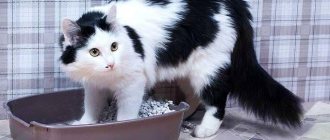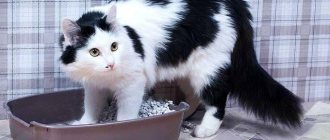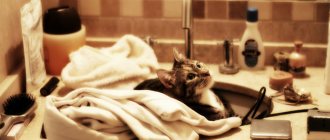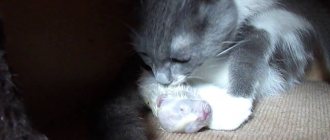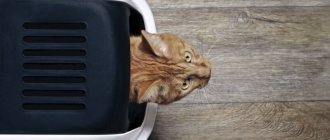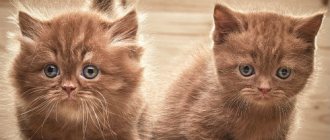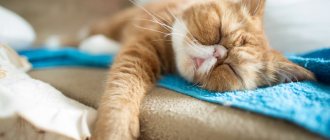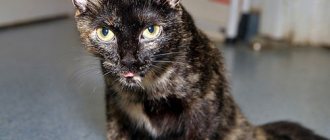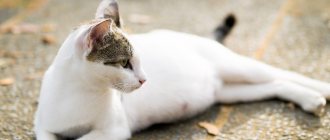A healthy cat with satisfactory maintenance and nutrition pees 3 to 5 times a day. Deviations from this norm may indicate an imbalance in water balance, which is easy to correct. To do this, you need to provide the animal with unhindered access to water at any time of the day.
However, there are accompanying signs that indicate the development of pathologies of the genitourinary system. They lead to difficulty urinating. Every owner should know about these symptoms in order to pay attention in time and provide competent assistance to the pet.
Norms of urination in cats and cats
The number of urinations per day in adult cats and female cats may vary slightly. This is due to the difference in the structure of the genitourinary organs of males and females. Due to the longer and narrower urethra, cats need to pee 3 to 5 times a day.
While cats need 2-3 times a day. This multiplicity does not depend on previous sterilization or castration, so any deviations from the norm should be perceived by the owner as an alarming signal.
4.Treatment
Rare urination is always a symptom of pathology or at least an anomaly, but this symptom itself cannot be treated: of course, the disease, the etiopathogenetic root cause, must be treated. Accordingly, therapeutic strategy and tactics are entirely determined by the diagnostic results; In addition, prescriptions always take into account many purely individual characteristics, so it is impossible to outline at least in general terms all possible schemes of treatment prescriptions. It should, however, be emphasized once again: urinating too infrequently is just as serious a symptom as urinating too often, and in any case you need to take it seriously: consult a doctor as soon as the tendency becomes obvious, and not wait until much more severe manifestations and complications.
Why can't my cat pee?
The reasons why the cat was unable to go to the litter box may be external factors. Usually, after eliminating them at home, the process of urination returns to normal without medical intervention.
These factors include:
- insufficient water consumption;
- prolonged stay in a hot room or outdoors in the summer;
- a sudden change in diet (transferring cats to dry ready-made food);
- moving to a different climate zone;
- stress;
- surgeries on the genitourinary system.
Sometimes a cat cannot pee for a long time after abdominal surgery on the abdominal organs or intestines. This is due to the fact that during the administration of general anesthesia, the animal involuntarily empties the bladder, and the slowdown of all vital processes in the body during anesthesia prevents it from filling quickly.
Important! If two days after castration the cat still cannot pee or the cat does not go to the toilet in a small way, then you should contact a veterinarian.
But there are also pathological reasons that a cat cannot go to the toilet in a small way, in which a person must help the pet.
Urolithiasis disease. This disease often develops in cats that do not receive adequate physical activity, and the basis of their diet is dry food.
When a cat doesn't drink enough and doesn't urinate enough, crystals begin to form in the kidneys, which gradually form into stones. At the first stage of the disease, the animal begins to frequently go to the toilet in small portions, since sand and larger stones constantly irritate the mucous membrane of the bladder and urethra. But at the moment when stones get into the ducts and block them completely, cats cannot go to the toilet in a small way. Urine accumulates in the bladder and, if left untreated, leads to rupture of its walls.
Important! Problems with urination and digestion in cats arise when the owner makes a serious mistake and begins to feed his pet both natural and ready-made food. The imbalance of such a diet also often leads to allergic reactions, hair loss, eczema and other skin diseases.
Cystitis. Inflammatory processes in the bladder in cats and cats in the first phase of development provoke frequent urination and pets can go to the toilet a little every hour. But if left untreated, the disease enters the second phase, in which swelling of the urinary canal prevents the outflow of fluid and the cat cannot pee.
You should not treat cystitis in cats on your own, since the pathology that is not completely cured will constantly manifest itself in relapses. You should also find out the reasons for the development of the disease and its type.
The fact is that the struvite-induced form of cystitis is a harbinger of urolithiasis. Inappropriate treatment in this case will provide temporary relief, but will subsequently lead to the cat being unable to pee due to kidney stones.
Note! Experts identify an idiopathic form of cystitis, which presumably occurs against the background of severe stress. Therefore, if after a stressful situation the cat does not go to the toilet, you should urgently contact a veterinary clinic.
Anomalies of the development of the genitourinary apparatus in cats. Sometimes this pathology manifests itself in the first months of an animal’s life, when the kitten does not go to the toilet very often or the process causes difficulties for him. But there are cases where manifestations of congenital anomalies are observed in pets in adulthood.
At first, the cat begins to rarely go to the toilet in small ways without pain. But hypothermia or bacterial infections can trigger inflammatory swelling, which leads to a lack of urination for 2 or more days.
The reason that cats urinate little may be prostatitis. In the acute form of the disease, there is no full urination, but droplets of bloody discharge appear from the urethra, the animal’s posture indicates severe pain in the abdominal area.
In the chronic form, the cat does not go to the toilet very well, but does not show signs of anxiety.
Important! The risk of developing urolithiasis and other pathologies of the genitourinary system in cats increases after sterilization. Therefore, if a neutered cat cannot pee in the toilet, you should immediately visit a veterinary clinic for catheterization.
3. Symptoms and diagnosis
In some cases, infrequent urination may not be accompanied by any additional symptoms and/or sensations. However, if the reduction in the frequency of urination is not purely situational, physiological, transient, then the asymptomatic period sooner or later ends and gradually increasing signs of the true, pathological cause of urinary retention and/or reduction in daily urine volume appear. Such symptoms are most often associated with the mictional (urinary) act of pain, pain in the lower abdomen (of various types, often radiating to adjacent areas), forced tension, without which urine does not begin to flow, a feeling of incomplete emptying of the bladder, weakening, bifurcation or unusual spraying of the stream, dependence of its emission on body posture (in some cases, for example, if there is a stone in the urinary tract, urination becomes possible only with a certain tilt or turn) and other uncomfortable sensations. Sometimes rare urination is combined with drip “leaking” or other forms of urinary incontinence (for example, the urge appears suddenly and almost immediately becomes imperative, unbearable).
The cause is established during a urological examination, collecting anamnesis and complaints (signs such as complexion, characteristic swelling, rapid loss or gain of body weight, etc. are also important), studying the dynamics, as well as additional diagnostic procedures. Sometimes, to identify a pathological factor, a rather long, thorough and multifaceted examination is necessary, incl. application of modern methods of instrumental and laboratory diagnostics. As necessary, tests of urine, blood and other biological media are prescribed (clinical, biochemical, hormonal, bacteriological, etc.), modifications of X-ray studies accepted in urology (survey and excretory contrast urography), urocystoscopy, ultrasound, CT, MRI etc.
About our clinic Chistye Prudy metro station Medintercom page!
The main signs of the disease
The main sign that a cat cannot pee is when the animal walks around the tray and meows pitifully. Some owners notice that their pets sometimes behave in this way during heat. But you should distinguish between these reasons in order to promptly help a cat who cannot go to the toilet in a small way at home.
A sick pet exhibits the following clinical signs:
- depressed state;
- unnatural posture with an arched back, a bent neck and knees pushed forward;
- enlargement of the abdomen due to a full bladder;
- decreased or lack of appetite;
- increased body temperature;
- plaintive meowing or screaming during sudden attacks of pain.
If the cat begins to pee a little, then you should pay attention to the quality of the urine. It may change from a light yellow color to an orange or brown tint due to the presence of blood cells. Also, the urine will emit an unpleasant purulent odor, and its structure will become grainy due to crystalline inclusions or sand.
Note! Sometimes a sign that your cat can't pee is stretching out its back legs and licking the genital area for a long time. Also, if it is painful for a cat to go to the toilet in a small way, he lies down near the tray and meows pitifully, demonstrating his problem to the owner.
What are the normal urination rates?
Normally, the daily volume of urine produced in the body of domestic felines should be from 50 to 200 ml. Naturally, these indicators depend on the personal characteristics of the animal: gender, age, weight, feeding system and activity of the animal.
Newborn kittens usually pee once a day. As it grows, the number of urinations increases up to 3 times by 2-3 months, and upon reaching six months of age, an active furry can run to the toilet up to 6 or even 10 times! As he grows up, he will begin to drink less, and the urge to pee will occur less and less often; 5 trips for “minor needs” will be enough.
To understand whether everything is normal with a kitten's urination, observe how often he sleeps and drinks, since it is after these procedures that he pees most often. The coincidence of indicators will indicate that he has no problems with urine output.
If you are interested in how many times a day a cat that is already mature and in a healthy state should pee, then there are no strict indicators here either. Don't be surprised if you notice that he visits the toilet 2 times more often than his cat relative. This obvious difference is explained by physiological reasons: in cats, the urinary canals are narrower and more curved, which inhibits the outflow of urine and forces them to walk “small” more often. This same specific structure of the urinary system is to blame for the fact that representatives of the male half of the cat family are more susceptible to developing urolithiasis than females.
What to do at home if your cat can't pee
The first thing to do if your cat cannot go to the toilet is to take him to the clinic. The doctor will be able to quickly assess the danger of the situation and take radical measures to alleviate the animal’s condition.
First aid
But sometimes circumstances develop in such a way that it is not possible to quickly bring your pet to the hospital. In this case, you should know what to do and how to provide first aid at home to a cat who cannot pee.
To relieve spasm and relax the smooth muscles of the ureters and bladder, male cats should be given an intramuscular injection of No-shpa or Papaverine.
Important! If a cat rarely goes to the toilet or has completely absent urination for more than a day, then giving diuretics is strictly prohibited.
If the cat cannot pee, then as therapy at home you can treat it with Cat Erwin, and also inject it with an antibacterial drug (Tsiprolet, Baytril).
This will help relieve spasm and reduce inflammation for a short period of time. This period should be used to take the cat to the clinic or call a veterinarian at home.
Important! You shouldn’t try to do something on your own if the cat hasn’t been able to pee for 2 days or is screaming in pain or won’t let you touch her belly. In this case, only immediate catheterization can save her from death.
Veterinarian actions
After examining the cat and making a preliminary diagnosis, the veterinarian carries out treatment. It can be roughly divided into 4 stages:
- Preventing stretching and rupture of the bladder in a cat or cat that has not gone to the toilet for more than two days. To do this, a soft catheter with an attached closed system for collecting urine is inserted into the animal. For sterilized cats that periodically cannot pee after castration, a temporary catheter is placed. This is necessary to reduce the risk of developing ascending bacterial infections.
- Stimulation of the bladder muscles. The most effective drug for this is Bethanechol. However, multiple side effects and the need for urgent administration of an antidote in case of intolerance make it possible to use it only in a hospital setting, under the strict supervision of a physician. Cisapride and Propanolol are considered safer drugs for cats. But their independent administration is also prohibited.
- Decreased tone of the urethra and bladder neck. If the obstruction is not associated with anatomical developmental abnormalities, then a cat who has stopped peeing and does not recover for a long time after catheterization is prescribed muscle relaxants (Acepromazine, Diazepam) and alpha-adrenergic antagonists (Phenoxybenzamine, Prazosin).
- Prevention of the development or relief of infectious processes in the lower urinary tract. They often cause systemic inflammation, which can be fatal. Therefore, a veterinarian must prescribe antibacterial drugs to a cat that has not gone to the toilet for the second day or more than 2 days.
Note! The optimal way to select antibiotics is to conduct a preliminary bacteriological study of urine to determine the sensitivity of pathogenic microorganisms to certain drugs. In this case, you can achieve effective results and spend less time treating a cat that cannot pee.
Treatment options
At home, it is impossible to diagnose and carry out full effective treatment for a cat that cannot pee in the litter box on its own. This is due to the fact that in addition to conservative methods of therapy, surgical intervention is often used to eliminate this syndrome.
The most common indications for surgery in cats are malignant and benign tissue growths, as well as urolithiasis. A somewhat less common reason for performing surgery on a cat that rarely goes to the toilet is anatomical anomalies in the structure of the organs of the genitourinary system.
How often should a cat pee?
The cat’s urinary system is quite complex; it works individually, and this depends on many factors:
- age;
- gender;
- breeds;
- dimensions;
- activity and lifestyle;
- psychological state;
- power systems;
- amount of fluid consumed, etc.
These indicators also affect how much urine is collected per day in the cat’s bladder - it can range from fifty to five hundred milliliters. A condition in which the bladder does not empty its contents immediately, but in small portions, a little at a time, is called pollakiuria. In this case, the cat repeatedly visits the toilet.
All cats decide on a toilet issue individually.
From childhood to old age
While the kitten is very small, its digestive and excretory organs are still undeveloped - they are in the process of formation. The baby feeds exclusively on mother's milk, which is ideal for him and is almost completely digestible - in the first couple of weeks, one urination a day is enough.
Growing kittens have a fast metabolism, and they use the litter box more often than adults.
As you grow further, this conditional norm will be adjusted more than once. During the period of maturity, metabolic processes stabilize, and fluid consumption decreases accordingly. As a result, the number of visits to the tray for minor needs is reduced to an average of three.
In older animals, the functioning of the excretory system can be affected not only by age itself, but also by other reasons:
- excess weight;
- chronic diseases of internal organs;
- increased sensitivity to temperature conditions and other external stimuli;
- physical inactivity, low activity;
- poor appetite, slow metabolism.
Old age is not a joy: I came to the litter box, forgot why and fell asleep
Boys and girls
It is important to know that these indicators can differ significantly between male and female cats, because their excretory systems are structured differently. A cat's ureters are much thinner and more tortuous, which is why he is unable to completely empty his bladder at one time and has to do it in several passes.
Therefore, do not be surprised or alarmed if your Murzik runs to pee twice as often as your Murka - this is a completely normal phenomenon.
A cat, cat and kittens can go potty with different frequencies
Special diet
After establishing the reason why the cat cannot pee and carrying out treatment, you should make the right choice of ready-made cat food or change the diet from natural products.
Among industrial cat foods, preference should be given to holistic ones. But the high cost and difficulties in purchasing sometimes become an obstacle for owners. Therefore, they can be replaced with super premium food.
Important! Sometimes owners have a hard time getting their pets to switch to holistic. This is due to the lack of flavor enhancers and flavoring agents that are added to lower class feeds.
In case of urolithiasis, the diet of cats that eat natural food should be adjusted depending on the type of stones. To do this, you need to consult a veterinary nutritionist or attending physician, who will base his recommendations on laboratory data.
| Type of stones | Authorized Products | Prohibited Products |
| Phosphates | rice, buckwheat, oatmeal; | whole milk; |
| boiled beef and rabbit; | hard and fermented milk cheese; | |
| boiled liver | Fish and seafood | |
| Oxolates | boiled carrots, cauliflower; | offal; |
| boiled dietary meat | Fish and seafood; | |
| milk | ||
| Urats | allowed boiled vegetables; | meat and fish broths; |
| lamb, duck, non-lean beef | offal; | |
| lean meat; | ||
| asparagus; | ||
| cauliflower; | ||
| legumes |
For any type of stone, cats can be given pureed baked apples and pears.
Treatment of diseases of the urinary system
Self-treatment of your pet is unacceptable. The only thing the owner can do to help his cat is to show him to a veterinarian so that he can determine the cause of the painful condition, find out why the animal cannot pee, and prescribe adequate treatment.
Regardless of the reason why a cat does not pee, the first step of therapy should be aimed at restoring the flow of urine and eliminating pain in the animal. Common diseases of the urinary system and features of their treatment:
- Urolithiasis disease. Pathology occurs due to the formation of stones in the bladder. An animal can sit in a tray for a long time, but still not go to bed. If a small amount of sand or small stones is detected, conservative therapy is carried out. The animal is prescribed anti-inflammatory and painkillers, IV drips and diet. If the urinary tract is blocked, catheterization or surgery is required - urethrostomy, when a new opening is formed for urine output.
- Cystitis. Bladder inflammation requires immediate specialist intervention. The pathological process can be quickly stopped with the help of antispasmodic, antibacterial, diuretic and hemostatic drugs (if there is blood in the urine). Advanced cystitis becomes chronic and periodically torments the pet with severe attacks. Treatment of cystitis should also include therapy for the disease that provoked the pathological process - urolithiasis, urethritis, diabetes mellitus, etc.
- Urethritis. Inflammation of the urethra is mainly diagnosed in castrated cats. The risk of developing an inflammatory process is increased by urolithiasis of the kidneys and bladder, nephritis, urethral injuries, etc. Therapy for inflammation includes antiseptic treatment of the pet’s urethra, the use of painkillers, antihistamines and diuretics. In severe cases, the urethra is washed with a solution of silver ions.
- Atony of the bladder. Weakening of the walls of the organ may be associated with poor nutrition, the presence of stones and inflammation in the genitourinary system, spinal injury, age of the pet, etc. In this case, the animal not only urinates little, but may also involuntarily urinate in its sleep. With anuria, there is a high risk of bladder rupture, so you need to install a catheter in your pet as soon as possible to remove urine. Next, conservative treatment is carried out using antibacterial, anti-inflammatory and drugs that stimulate the tone of the bladder walls.
Pathological causes of frequent urination
Frequent urination is often not associated with various diseases of the genitourinary system
However, it is important for any owner to know how such pathologies manifest themselves in order to provide first aid to the animal and take it to the veterinarian in time
Cystitis
This disease is one of the most common genitourinary diseases in domestic cats. The initial stage of the pathology has no external manifestations, but over time, inflammation of the bladder mucosa causes urination problems.
Any pet owner can recognize the signs of the disease:
- the cat often sits down to pee, but there is no urine, or it comes out in small portions;
- the animal begins to meow before urination begins, and continues to do so during the process;
- the pet often licks the perineum;
- the cat has a tense stomach and sometimes starts vomiting;
- the animal is thirsty all the time;
- urine has changed color to darker;
- the appearance of an ammonia odor from animal secretions.
Cystitis cannot be neglected, as it can become chronic. The most common causes of pathology are the animal’s lack of protein food, a small amount of fluid, infection, hypothermia, kidney inflammation, and helminthic infestation.
Urolithiasis disease
This disease most often develops in older or neutered animals. Rarely, the disease is diagnosed in young pets.
If your cat often runs to pee and his appetite has decreased, measure the animal's body temperature. Elevated levels combined with lethargy, vomiting and dark-colored urine almost certainly indicate the development of urolithiasis. Pathology is caused by:
- unhealthy diet with a predominance of foods that contain purines, calcium, phosphorus, potassium;
- flavored and canned additives from inexpensive industrial feeds;
- infectious lesions;
- excess weight;
- lack of water for drinking;
- predisposition to the disease at the genetic level.
Diabetes
This disease is called "fat man's disease." Diabetes most often affects overweight pets. Their body does not cope well with the absorption of glucose, so animals instinctively try to lower its concentration with large quantities of water.
Table 2. Signs and causes of diabetes in cats
| Symptoms of the disease | What causes the disease |
| The cat often goes to the toilet in small quantities, but the amount of urine does not decrease | Stressful state |
| The animal is very thirsty, regardless of the weather | Disturbance of hormonal processes |
| The pet does not feel pain during urination (if the disease is not advanced) | Pregnancy |
| In the case of a long-term illness, the cat’s weight drops sharply, interest in games disappears, vomiting may begin, and appetite changes are observed. | Using inappropriate foods in the diet |
When diabetes develops, a cat's breath begins to smell like acetone. If such a symptom appears, it is necessary to urgently show the animal to a doctor.
Cushing's syndrome
This pathology is hormonal and is rarely diagnosed in domestic animals.
To prevent possible illness, it is important to carry out preventive examinations on a regular basis.
The disease can be triggered by treating your pet with corticosteroids or a tumor in the adrenal gland or pituitary gland. Hormonal imbalances lead to impaired cortisol production, which gives rise to the development of Cushing's syndrome.
Signs of the disease:
- loss of appetite, rapid weight gain;
- thirst;
- frequent urination;
- development of apathy;
- the appearance of defects on the pet’s skin and fur.
Sometimes Cushing's syndrome develops as a result of diabetes. To establish a diagnosis, special tests are performed, urine and blood tests are performed, and the animal is given x-rays and ultrasounds.
